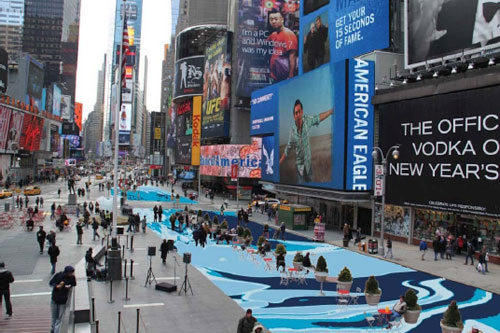Times Square Transformation
If you have walked along Broadway in the last year, you are familiar with the traffic-calming measures taken by NYCDOT. The goal is to make NYC streets more pedestrian and bicycle friendly due to a large number of deaths and injuries caused by vehicles. The public plazas at intersections along Broadway have had large green dots scattered since its inception. Recently, the Department of Transportation decided to take the opportunity to beautify these plazas. As a part of the reNEWable Times Square project, artist Molly Dilworth’s “Cool Water, Hot Island” surface treatment, is currently being installed for an 18 month run “on Broadway”.
The success of Times Square as a large public space has prompted city officials to lead a long-term transformation of the area. Norwegian firm, Snøhetta, has been charged with the task of the overhaul. Snøhetta is no stranger to creating large scale architecture with major public components. Most notably, the Oslo Opera House capitalizes on it’s roofscape as a major public space along the waterfront. Snøhetta is a great example of an architecture firm which design’s for the public sphere. They manipulate program and are not tied down to traditional typologies. An opera house typically radiates an attitude of inaccessibility and elitism. The Oslo Opera House, flips that notion on its head and believes that everyone can get something out of it. This perception has been more “in” than “out” since NYC’s Met Opera began showing their most popular and sold-out performances for free in major public spaces (i.e. Times Square).
The Opera House was a catalyst for development and revitalization. It is truly an urban project and example of the architect/urbanist. The project description reads:
The operahouse is the first element in the planned transformation of this area of the city. In 2010 the heavy traffic beside the building will be moved into a tunnel under the fjord. Due to its size and aesthetic expression, the operahouse will stand apart from other buildings in the area. The marble clad roofscape forms a large public space in the landscape of the city and the fjord. The public face of the operahouse faces west and north – while at the same time, the building’s profile is clear from a great distance from the fjord to the south. Viewed from the Akershus castle and from the grid city the building creates a relationship between the fjord and the Ekerberg hill to the east. Seen from the central station and Chr. Fredriks sq. the opera catches the attention with a falling which frames the eastern edge of the view of the fjord and its islands. The building connects city and fjord, urbanity and landscape.
Thus, the selection of Snøhetta to transform one of the most famous public spaces in the world, seems to be a wise choice. The Times Square improvements include designing a desirable pedestrian experience and updating infrastructure in order to better serve the many events held in the square. Craig Dykers, head of Snøhetta said, “Our goal is to improve the quality and atmosphere of this historic site for pedestrians and bicyclists while also allowing for efficient transportation flow for the betterment of the city.”
As a side note, while I was perusing NYC Department of Transportation’s (DOT) website, I was pleased to see many public initiatives in effect:
Community Presentations: transparency, public opinion
Bus Rapid Transit: branding/identity, bus lanes, high capacity vehicles, high visibility stations, designed to reduce travel time, improve reliability, and increase the level of comfort for bus customers
Brooklyn Bridge Gateway Construction: redesign gateway into Brooklyn, make it safer & more of a welcome mat
Bicycle Network: adding bike lanes
Safe Streets for Seniors: looking at variables like visibility, lighting, drivers’ compliance with traffic and pedestrian signals and the width of the roadway
reNEWable Times Square: surface treatment mentioned above
Street Design Manual: provides policies and design guidelines to city agencies, design professionals, private developers and community groups for the improvement of streets and sidewalks throughout the five boroughs. It is intended to serve as a comprehensive resource for promoting higher quality street designs and more efficient project implementation.
Urban Art Program: temporary art installations to invigorate streetscapes
NYC Plaza Program: creating neighborhood plazas throughout the city via underused streets, a key part of the City’s effort to ensure that New Yorkers live within a 10-minute walk of quality open space
Jackson Heights Transportation Study: improve pedestrian/vehicular safety, economic vitality through transportation improvements, quality-of-life by minimizing air pollution, identify, and prioritize, types of users for streets and public spaces, encourage use of efficient and sustainable modes of transportation, & efficient use of on-street parking
Congested Corridors: study of 14 busy roadways across 5 boroughs, with goal of improving mobility, air quality, safety, and the quality of life for all street users
Check Out: http://www.nyc.gov/html/dot/html/home/home.shtml


Trackbacks